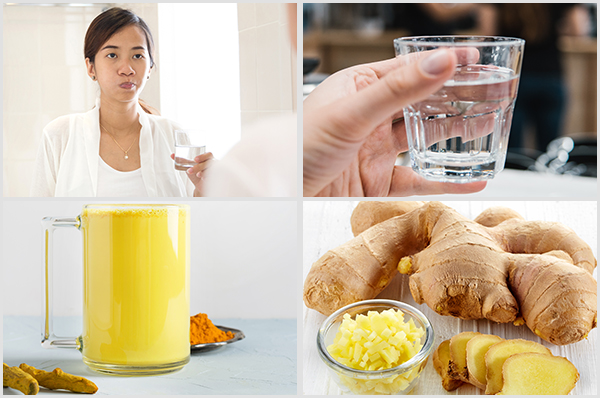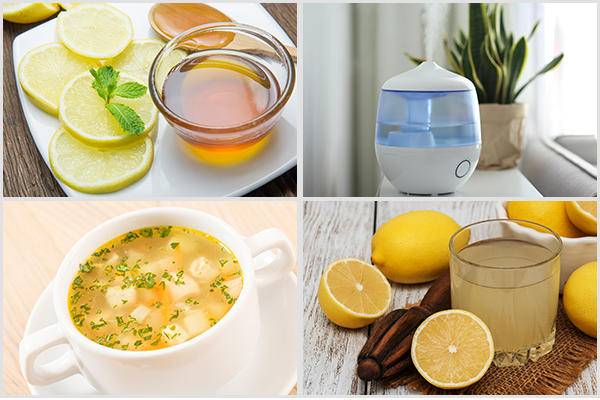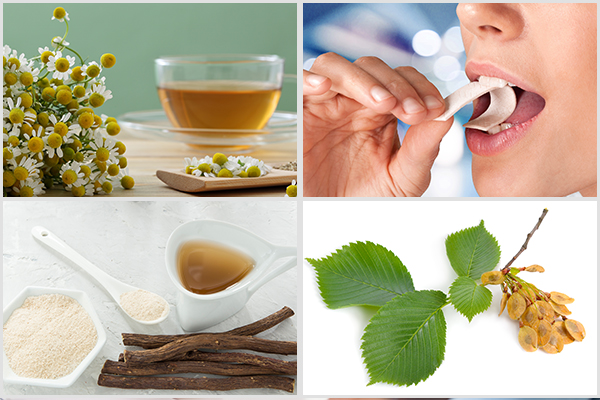In this article:
Much like breathing, the act of swallowing is so basic yet necessary that we do it without even realizing it. However, this fundamental function can be rendered quite difficult and painful if your throat becomes too dry or you contract an illness that affects your ability to swallow.

Painful swallowing, also called odynophagia, refers to any kind of pain or discomfort that one experiences while swallowing food or drinking liquid. This is a common problem that is usually symptomatic of some underlying ailment and is prevalent in people of all ages.
Home Remedies for Odynophagia (Pain When Swallowing)
Here are 12 home remedies to deal with pain when swallowing.
1. Gargle with salt water
To reduce pain when swallowing due to a sore throat, gargle with warm salt water. The warm water has a soothing effect on the throat, and the salt helps kill any virus or bacteria that may be causing the throat infection.
Plus, the salt helps reduce swelling and inflammation in the lymph nodes in the neck.
A 2011 study published in the Journal of Family Practice found that doctors in clinical settings still recommend salt water gargles for throat pain. (1)
How to do:
- Mix ¼ teaspoon of salt into 1 cup of warm water.
- Gargle with this solution, but do not swallow it.
- Do this a couple of times daily for about 1 week.
2. Drink warm liquids
Increasing your fluid intake is important to keep your body hydrated and your throat moist. However, to reduce pain when swallowing, it is recommended to sip warm liquids as much as possible.
According to a 2008 study published in Rhinology, drinking a hot drink provided relief from most symptoms of the common cold and flu as compared with any drink at room temperature. (2)
Any hot beverage will help soothe your throat, but try to avoid caffeine, which is dehydrating in nature and thus can worsen the symptoms.
A glass of warm water, milk, or any herbal tea will help. For added benefit, you can add a little honey to your warm beverage before drinking it.

3. Drink warm turmeric milk
Drinking warm turmeric milk can help bring down the swelling of enlarged lymph nodes and help treat strep throat and the common cold. Plus, it has anti-inflammatory and analgesic properties that help reduce swelling and pain. It can also fight infections and boost immunity.
A 2013 study published in Pharmacognosy Research highlights the antimicrobial, anti-inflammatory, and immune-stimulatory activity of curcumin, one of the main components of turmeric. (3)(4)
How to consume:
- Mix 1 teaspoon of turmeric powder and a pinch of ground black pepper into 1 glass of warm milk.
- Optionally, add a little honey.
- Drink this warm turmeric milk twice daily to speed up the healing process.
4. Take ginger
Ginger can be helpful in reducing the pain in your throat that causes difficulty swallowing. It has antiviral, expectorant, and anti-inflammatory properties that help fight any kind of infection and pain.
A 2005 study published in the Journal of Ethnopharmacology reports that ginger possesses analgesic and anti-inflammatory properties. (5) This means it can help reduce pain and inflammation in the throat. (6)
Plus, it is soothing for digestive troubles as well.
How to consume:
- Make ginger tea by adding 1 teaspoon of freshly grated ginger to 1 cup of boiling water and letting it steep for a few minutes. Add some raw honey and lemon juice. Enjoy this tea up to three times a day.
- Also, you can grate fresh ginger and eat a small amount several times a day.
5. Use a combination of lemon juice and honey
When it comes to strep throat, the common cold, or tonsillitis that is causing pain when swallowing, the combination of lemon and honey works well.
The vitamin C in lemon helps combat the growth of bacteria that cause strep throat as well as promotes overall health. Honey keeps the throat well moisturized and relieves soreness and inflammation.
According to a 2017 study, the combination of honey and lemon juice has promising antibacterial activity against the bacteria that cause respiratory tract infections. (7)
How to consume:
- Mix 1 tablespoon each of honey and lemon juice into 1 cup of lukewarm water.
- Sip the mixture slowly.
- Drink this as often as needed for several days.
6. Use a humidifier
To get relief from a sore throat and reduce the pain you are experiencing when swallowing, it is helpful to breathe in moist air.
A humidifier converts water into moisture that slowly fills the air. This increases the humidity in the room, and breathing in this moist air can ease throat inflammation and relieve a sore throat.
A 2009 study published in Respiratory Medicine found cold temperature and low humidity to be associated with increased occurrence of respiratory tract infections. (8) Respiratory tract infections are among the few reasons behind a sore throat.
Use a humidifier wherever you spend most of your time and also in your bedroom to add moisture to the air while you sleep. Be sure to clean the humidifier when needed and change the water daily so that bacteria do not grow.
7. Consume homemade chicken soup
When suffering from pain when swallowing solid food, you must opt for a liquid diet. In this regard, nothing can be better than a bowl of warm and soothing homemade chicken soup.
Homemade chicken soup is rich in anti-inflammatory properties as well as vitamins and minerals that help deal with sore throat or inflammation in the throat. In addition, the nutrients in chicken soup boost immunity.
A 2000 study published in Chest suggests that chicken soup contains a number of substances with beneficial medicinal activity for upper respiratory tract infections. (5)
When cooking chicken soup at home, use organic chicken and include onion, ginger, garlic, cayenne pepper, and carrots.

8. Lemon water for soreness
Lemon is one such ingredient that can give these trusted healing aids a run for their money. This citrusy delight is great for sore throats as it helps dissolve the mucus, making its elimination a lot easier and thereby providing symptomatic relief. (9)(10)
Another important therapeutic facet about lemons pertains to their rich antioxidant content, primarily vitamin C, which can help to bolster your immune system to fight off infections such as laryngitis.
How to use:
To reap the healing potential of lemon, simply mix 1 teaspoon of its juice into a glass of warm water and gulp it down for quick relief.
9. Drink chamomile tea
This noncaffeinated herbal tea is just the thing for you if your throat pain is due to a case of laryngitis. Besides being a soothing beverage, chamomile tea helps your sore throat heal on account of its potent antiseptic and anti-inflammatory properties. It provides symptomatic relief from the pain when swallowing, thereby making you feel less irritable. (11)
Both fresh chamomile flowers and dried flower buds can be used for brewing this tea. However, if you wish to optimize its pharmacological benefits, make sure to fix yourself a fresh cup every time rather than drinking stale leftover tea.
- Put 2 tablespoons of dried chamomile buds or 4 tablespoons of fresh flowers in a bowl.
- Boil a cup of water and pour it over the chamomile buds.
- Cover the bowl, and allow the buds to soak in the hot water for 10 minutes.
- Once the flavor has been extracted into the liquid, filter out the tea and drink it warm.
10. Try chewing gum
If the pain when swallowing is due to acid reflux, try chewing gum.
Chewing gum stimulates saliva production, which in turn washes away the acid accumulated in the gut. Being alkaline, saliva also helps neutralize stomach acids.
A 2005 study published in the Journal of Dental Research found that chewing a piece of sugar-free gum for about 30 minutes after a meal can help relieve symptoms of gastroesophageal reflux disease. (12)
All you need to do is pop a sugar-free or cinnamon-flavored piece of gum in your mouth after a meal and chew it slowly.
11. Take licorice
Licorice and its natural compounds have anti-inflammatory activities. (13)
A 2017 study published in Bioorganic & Medicinal Chemistry highlights the antitussive and expectorant activities of licorice. (14) It can soothe tonsillitis, treat a sore throat and relieve dry and wet cough.
- Add ½ teaspoon of licorice root to 1 cup of hot water. Cover and steep for 10 minutes, and then strain. Add a little honey and drink this tea two to three times a day.
- You can also suck on some licorice candies.
Note: Avoid licorice if you suffer from coronary disease or high blood pressure.

12. Slippery elm can be beneficial
Slippery elm contains mucilage, a gel-like substance that can ease soreness, inflammation, and pain in the throat. (15) In fact, slippery elm is a traditional remedy for sore throat.
Due to its mucilage content, slippery elm is also useful for easing heartburn and acid reflux.
- Add 1 teaspoon of the inner bark of slippery elm to 2 cups of boiling water.
- Cover the pan and allow the water to simmer for 5 minutes.
- Strain the liquid, add a little honey to it, and drink it slowly while it is still warm.
- Drink this tea two to three times a day.
You may also try slippery elm lozenges.
Note: Do not use this herb without medical advice if you are pregnant or breastfeeding. Do not use different formulations of slippery elm (such as tablets and liquids) at the same time, unless specifically directed to do so by a health care professional. Using different formulations together increases the risk of an overdose.
Causes of Odynophagia (Painful Swallowing)

Some of the most common causes of painful swallowing include:
- Common cold
- Flu
- Strep throat
- Chronic throat infection
- Acid reflux
- Tonsillitis
- Chronic cough
- Oral thrush
Other causes may include swollen lymph nodes in the neck, some kind of throat injury, an ear infection, and swallowing large chunks of foods or medicines.
Signs and Symptoms of Odynophagia (Painful Swallowing)
You may feel the pain high in your neck or lower down behind your breastbone. The pain often feels like a strong sensation of squeezing or burning, and it is most often triggered or worsened by eating certain foods.
If the pain is associated with some kind of infection, you may experience additional symptoms, such as:
- Fever
- Chills
- Constant headache
- Dry and persistent cough
- Excessive sweating
- Inflamed tonsils
- Fatigue and tiredness
Treating Odynophagia (Pain When Swallowing)
Odynophagia typically stems from some underlying cause that needs to be addressed in order to make a comprehensive recovery. Thus, the treatment for your swallowing discomfort will be determined once the root problem has been identified.
In most cases, oral medications should suffice to provide relief. If you happen to suffer from gastroesophageal reflux disease (GERD), which causes the stomach acid to creep back up into the pharynx and esophagus, trouble in swallowing is an obvious by-product.
In this case, the standard medicines to prevent such acidic reflux will inadvertently tackle your throat-related discomfort as well. By reducing the backflow of acid and allowing the throat to heal, you will be able to swallow without pain in due time.
People who may experience pain when swallowing due to an ongoing candida infection, or oral thrush as it is commonly known, are usually given antifungal treatments.
The patient may have to go under the knife in cases where the development of esophageal tumors or carcinoma is suspected, wherein surgical removal of these harmful cells is the only option to arrest the spread of diseases.
Diagnosing Odynophagia

In order to pin down the cause for your odynophagia, the doctor may conduct the following investigations:
- Nasoendoscopy: This procedure involves passing a flexible camera with a light affixed on it through your nostrils to get an inside view of the back of your nose, larynx, and throat.
- Esophagogastroduodenoscopy: This procedure entails passing a flexible tube with a camera and light attached to it through your mouth into your esophagus, stomach, and duodenum (first part of the small intestine).
- Imaging studies: X-rays or scans may also be done to get a more detailed analysis.
The Difference Between Odynophagia and Dysphagia
Dysphagia is another swallowing-related condition that is often confused with odynophagia. The former is characterized by an abnormal transit of solids and/or liquids through the food pipe, while the latter refers to pain during swallowing. Thus, dysphagia adversely affects the movement of contents through the esophagus, whereas odynophagia renders the process painfully discomforting.
Unlike painful swallowing, dysphagia is not considered to be a benign process as it may pave the way for dehydration, aspiration, nutritional deficiencies, or airway blockages.
There are instances where both dysphagia and odynophagia may occur simultaneously, making swallowing both difficult and painful. It is just as likely for both these conditions to manifest separately as well.
Dysphagia can be of different types depending upon its etiology, anatomic location (esophageal vs. oropharyngeal), and whether it is aggravated by solids or liquids. It is very important to correctly classify the dysphagia for the appropriate course of treatment to be determined accordingly.
Pain during swallowing, on the other hand, is commonly caused by an inflammation or infection from the oropharynx to the esophagus.
Additional Tips to Deal With Odynophagia
- Mix 1 to 2 tablespoons of raw, unfiltered apple cider vinegar into 1 cup of water and gargle with it. Do this three or four times a day.
- Add 1 teaspoon of raw, unfiltered apple cider vinegar and 1 teaspoon of raw honey to 1 cup of warm water. Drink the solution slowly two to three times a day.
- You may have to take antibiotics prescribed by your doctor to treat an infection of the throat, tonsils, or esophagus.
- You may also take anti-inflammatory medications to reduce inflammation in the esophagus, throat, or tonsils.
- Avoid substances that are known to irritate your throat such as allergens, chemicals, and cigarette smoke.
- You can suck on herbal lozenges to ease sore throat and throat pain.
- Get plenty of rest to ensure a quick recovery.
- Eat slowly and chew your food well.
- Eat soothing foods such as broth, cooked cereal, mashed potatoes, soft fruits, and yogurt, which are easy on your throat.
- Drink plenty of fluids to soothe and moisten your throat.
- Avoid very cold or very hot foods if they make your symptoms worse.
When to See a Doctor

It is important to consult your doctor if the pain is chronic, severe, or interferes with eating, drinking, or breathing. Such symptoms may be an indication of a more serious condition, including esophageal cancer. Contact your GP immediately if you have the following symptoms:
- Blood in your stools or your stools appear black or tarry
- Shortness of breath or lightheadedness
- Weight loss
Tell your health care provider about any other symptoms that occur with the painful swallowing, including:
- Abdominal pain
- Chills
- Cough
- Fever
- Heartburn
- Nausea or vomiting
- Sour taste in the mouth
- Wheezing
Final Word
Painful swallowing generally tends to be short lived, but in some cases, the discomfort may be associated with a more serious underlying medical condition. So, you must go for a proper diagnosis to determine the root cause of the problem.
Once you resolve the underlying condition, the discomfort will go away. You can also try some simple yet effective home remedies to reduce the severity and frequency of pain.
- Was this article helpful?
- YES, THANKS!NOT REALLY


